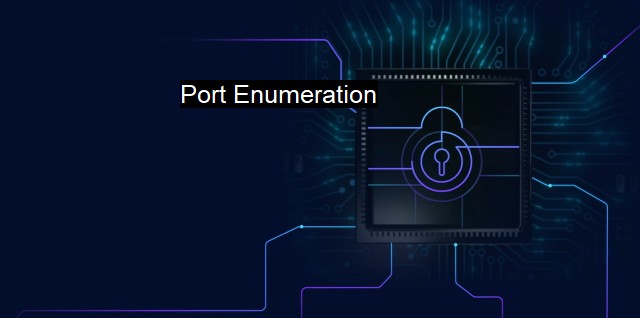What is Port Enumeration?
Port Enumeration: An Essential Technique for Cybersecurity Assessment and Penetration Testing
Port enumeration is a core concept within the realm of cybersecurity and antivirus protection systems. it entails performing a scan on a particular network or device to identify the open ports which can be utilized for communication. This process is vital in assessing security measures and implementing appropriate checks to guard against potential vulnerabilities.These communication ports on a network are integral to how networked computers communicate with each other and the external world. The ports facilitate sending and receiving of data, essentially underpinning the functioning of the internet and network operations. Each port is specific to a particular service or application, defined by a distinct port number from 0 to 65535. For instance, port 80 is utilized by a web server for HTTP traffic, while port 443 caters to secure HTTPS traffic. It is through these ports that protocols like TCP (Transmission Control Protocol) and UDP (User Datagram Protocol) communicate.
Unfortunately, cyber attackers can exploit these ports to intrude into a system or a network and compromise it, hence underscoring the importance of port enumeration. It enables network defenders to locate these entry points, pin down their nature, and implement robust cybersecurity measures.
Cybersecurity professionals perform port enumeration using a variety of tools. Among them is Nmap, a versatile tool which scans networks for open ports. Netstat, a command-line tool, is used for displaying active network connections, listening ports and the network statistics associated with these ports. These tools generate relevant data comprising of port numbers and the protocols used on those ports, which eventually provide insights into potential security vulnerabilities.
Port enumeration is thrilling to cybercriminals because it bears invaluable information about target systems. Cybercriminals may detect open ports, and by discerning the services running on these ports, plan their attack accordingly. if an old and vulnerable version of software or service is detected, they manipulate it to gain unauthorized access or distribute malware.
Protection systems such as antivirus software help combat such cyber threats. They function by scanning data coming through these ports for viruses and other malware. they patch detected vulnerabilities, rendering the system more secure and protected.
Firewalls also play a critical role in protecting against cyber-attacks that may evolve from port enumeration. They erect a barrier between the secured internal network and untrusted external networks. More specifically, firewalls operate through allowing, denying, encrypting, or decrypting traffic based on security rules, all serving to prevent unauthorized access through open or vulnerable ports.
Intrusion Detection Systems (IDS) and intrusion Prevention Systems (IPS) are further security layers for protection against such threats. They observe network traffic, identify suspicious activity, and respond by alerting IT professionals or even blocking the potential threat automatically. Regular security audits and penetration testing should also be used in addition to these systems.
Port enumeration is an indispensable part of cybersecurity that allows organizations to ascertain and strengthen their networks’ security postures. Comprehending how ports work, the types of applications and services running on these ports, and the myriad ways these can be exploited by attackers is crucial to crafting proper defence mechanisms. Robust solutions such as antivirus software and firewalls, combined with port monitoring tools like Nmap and Netstat, provide a solid basis for protection against potential security breaches. ongoing vigilance through routine security audits and penetration testing is paramount for effective security management.

Port Enumeration FAQs
What is port enumeration and how does it relate to cybersecurity?
Port enumeration is the process of scanning a network or computer system for open ports. In cybersecurity, this is often used by attackers to identify vulnerabilities in a system that can be exploited to gain unauthorized access. It is also important for antivirus software to detect port enumeration attempts, as this can be an indicator of a potential attack.What are some common tools used for port enumeration?
Some common tools for port enumeration include Nmap, SuperScan, and Netcat. These tools allow users to scan a network or system for open ports and services, which can be used to identify potential vulnerabilities. However, these tools can also be used maliciously, which is why it is important to monitor for port scanning activity.How can port enumeration be prevented?
Port enumeration can be prevented by disabling unnecessary services and closing unused ports. Firewalls and intrusion detection systems can also be used to monitor for and block port scanning activity. Additionally, it is important to keep software and system patches up-to-date to prevent known vulnerabilities from being exploited.What should I do if I detect port enumeration activity on my network or system?
If you detect port enumeration activity on your network or system, it is important to investigate the activity and take appropriate action. This may include identifying the source of the activity and blocking the IP address, or implementing additional security measures such as additional firewalls or stronger passwords. It may also be helpful to consult with a cybersecurity expert to ensure that your system is adequately protected against future attacks.| | A | | | B | | | C | | | D | | | E | | | F | | | G | | | H | | | I | | | J | | | K | | | L | | | M | |
| | N | | | O | | | P | | | Q | | | R | | | S | | | T | | | U | | | V | | | W | | | X | | | Y | | | Z | |
| | 1 | | | 2 | | | 3 | | | 4 | | | 7 | | | 8 | | |||||||